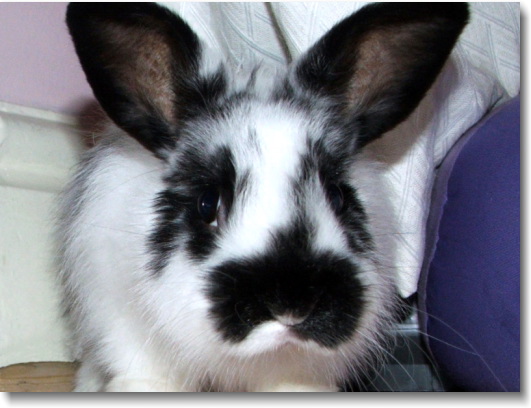Introduction
How big is a Rabbit anyway?
Weight: 2-3 lb (0.9-1.4 kg)Length: About 16 in. (41 cm) long.
Tail Length: 1.6-2.75 in. ( 40-70 mm).
Fur Color: Grayish brown above and white below.
Habitat: Sandy regions with shrubs and or woody plants, at altitudes of no more than 1,969 ft. (600 m) level.
Classification:
Phylum ChordataSubphylum Vertebrata
Class Mammaliaa
Order Lagomorpha
Family Leporidae
[3]

Image Source: ynskjen/ License under Creative Commons 2.0
Available in three sizes:
1280 x 1024 || 1024 x 768 || 800 x 600
The term rabbit, strictly speaking, comprises about 25 different species, in seven different genera, in the family Leporidae. [4] [5] [6] [7] A rabbit is a swift moving small herbivorous mammal, with big ears, large muscular hindlegs, large front teeth and a short tale. [8] [9] Their powerful hindlegs are built for running, jumping, and digging out burrows. [10] They have an excellent sense of smell, hearing, and eyesight. But their eyesight at night is actually worse than a human's. [11] [12] This is because they are crepuscular, chiefly active at twilight, the time between day and night. [13] Rabbits vary in size from 1 to 2 feet (30 to 60 cm) long. [14] Often people include hares in the term rabbit but these are two different genera. The main differences are, that hares have longer ears, bigger feet, do not live in burrows, and give birth to young that are not blind and naked from birth (precocial). [15]

Image Source: Tim Moore / License under Creative Commons 2.0
Available in three sizes:
1280 x 1024 || 1024 x 768 || 800 x 600
Rabbits are altricial, which means their young are born blind and naked, and require parental care. [16] In the wild, a rabbit will live about a year. [17] In comparison, a well cared for House rabbit can expect to live 8 to 12 years. [18] In the United States rabbits are raised mainly for nonfood purposes such as pets, medical and cosmetic research, and some high-quality rabbit skins. [19] China, on the other hand, is the world's leader in rabbit meat production with 31%. [20] In Europe and Asia rabbits are an important food source because of their fine grained white meat, which is high in protein, low in fat, and low in cholesterol. A rabbit carcass is only 20% bone and its meat can be easily substituted for poultry in many recipes. [21] The World Health Organization has recognized rabbit meat as the leanest meat in the world, and one of the healthiest. [22] In fact the lack of fat in rabbit meat is what leads to a condition called "rabbit starvation." This condition occurs because the simplest way for your body to generate energy is to convert carbohydrates into glucose. But if carbohydrates are not available to your body, it can convert fat into glucose; if fat is not available, it can convert protein into glucose. This process is called gluconeogenesis, and it takes place in the liver. A host of enzymes are necessary to do the work, and the conversion creates nitrogen waste that then must be converted into urea and disposed of through the kidneys. [23] However, a human's liver can only convert a limited amount of protein into glucose. Beyond a protein intake of 20-35% of total food intake, the amino acids in the meat are lost through the urine. [24] However, there is a limit to how much protein the liver's waste disposal systems can safely handle. If they are overwhelmed, it will lead to protein poisoning -- nausea, diarrhea, wasting, and death. [25] Early North American explorers such as Lewis and Clark described such symptoms from eating only lean meats. [26] Today's high fat diet now welcomes the same lean qualities that were lethal to our ancestors. Domesticated meat rabbits such as Champagne D'Argent, English lop, and Californian are characterized by weights between 8 to 12 lbs. (3.6 to 4.4 kg). They are raised both for their meat and their fur. [27] Large rabbits, called giants can weigh up to 25 pounds but few people raised them because their meat-to-feed ratio is less efficient than the meat group. Some examples of these are checkered giant, giant chinchilla, and Flemish giant. [28] A single rabbit can produce between 8 oz. to 3 lbs. (227 g to 1.4 kg) of wool per year. [29]
 | Home Page | Next Page... |
Copyright © 2008 Rabbit Pictures & Facts
Member of Fohn.net
Privacy Policy
Image Source for Eastern cottontail at top of page: William R. James, U.S. Fish and Wildlife Service.
Image Source for cottontail at bottom of page: Clinton & Charles Robertson / License under Creative Commons 2.0.
